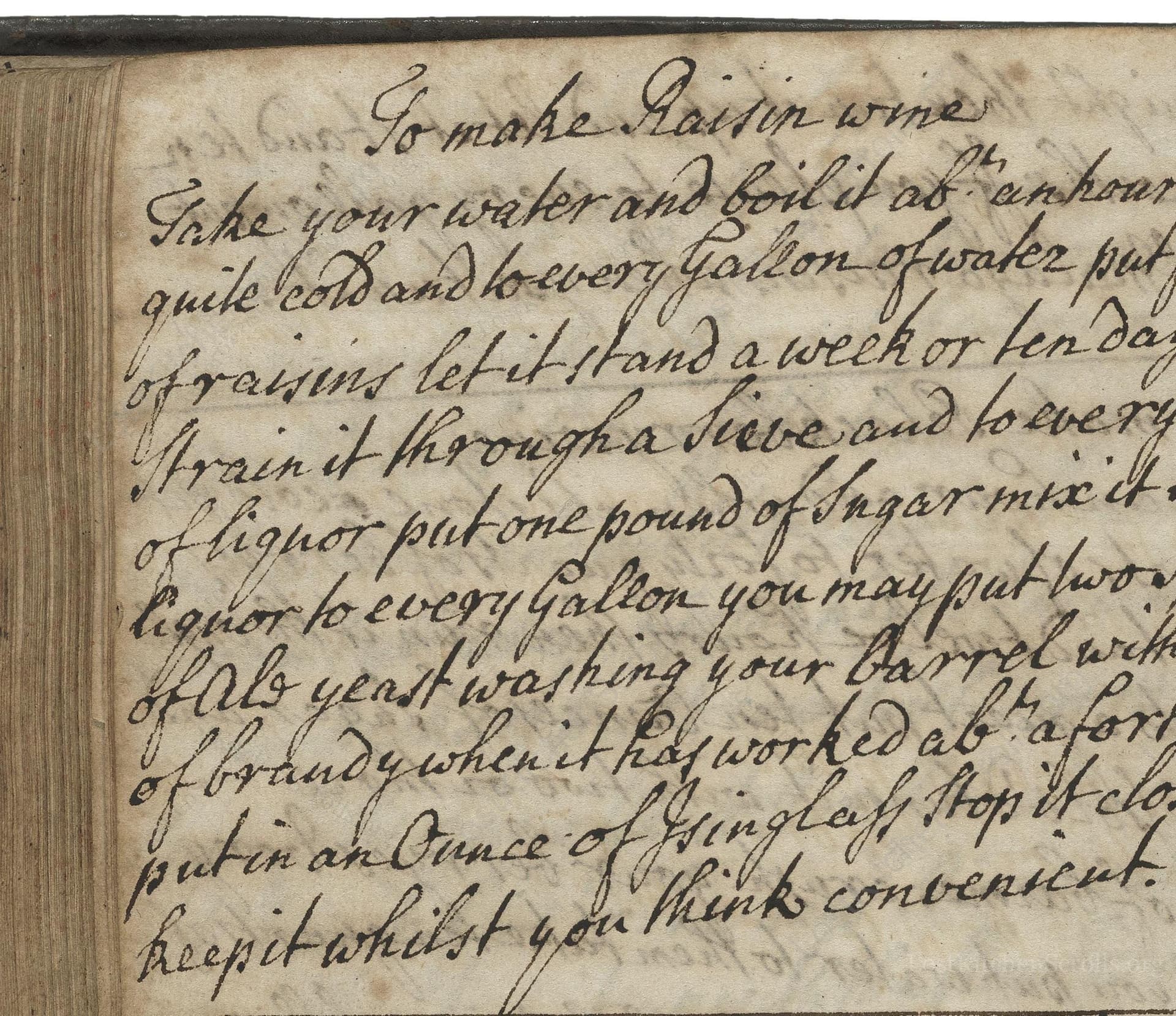To Make Raisin Wine
From the treasured pages of Receipt book by Beulah Hutson
Written by Beulah Hutson

To Make Raisin Wine
"Take your water and boil it about an hour let it be quite cold and to every Gallon of water put four pound of raisins let it stand a week or ten days then Strain it through a Sieve and to every Gallon of liquor put one pound of Sugar mix it with your liquor to every gallon you may put two Spoon fulls of Als yeast washing your Barrel with a Quart of brandy when it has worked ab. a fortnight put in an Ounce of Isinglass Stop it close up and keep it whilst you think convenient."
Note on the Original Text
In the late 1600s, recipes assumed practical household knowledge—measurements were relative, often in 'gallons' and 'pounds', and instructions were brief. Spelling was variable ('liquor' meant any liquid base; 'Als yeast' referred to ale yeast), and fermentation steps were second-nature to the audience. The text is direct but leaves much detail implicit, such as maintaining sanitation and temperature control, relying on the household's tradition and familiarity with brewing processes.

Title
Receipt book by Beulah Hutson (1680)
You can also click the book image above to peruse the original tome
Writer
Beulah Hutson
Era
1680
Publisher
Unknown
Background
A delightful journey into 17th-century kitchens, this manuscript stirs together rustic recipes and culinary secrets, inviting readers to savor the ingenious flavors of Beulah Hutson's time.
Kindly made available by
Folger Shakespeare Library
This recipe dates to around 1680 and comes from an English household collection compiled by Beulah Hutson. The late 17th century was an era of home brewing and domestic wine-making among the middling and upper classes, especially as imported wines were costly and often adulterated. Raisin wine was a luxurious way to create a sweet, fortified drink when grapes were scarce or prohibitively expensive in England’s cool climate. The high sugar content and brandy both increased shelf life, while brewing at home fostered creativity and thrift.

Brewing this wine in the 17th century would have involved large cauldrons or kettles for boiling water, wooden tubs or earthenware crocks for steeping the raisin-water mixture, and fine sieves or cloths for straining. Barrels or casks were used for fermentation, with isinglass (fish bladder) helping clarify the wine. A wooden spoon for stirring, a jug for ladling, and a funnel for transferring between vessels would also be common kitchen aids. The mention of 'Als yeast' suggests yeast sourced from ale brewing, a common byproduct in many historic kitchens.
Prep Time
15 mins
Cook Time
1 hr
Servings
16
We've done our best to adapt this historical recipe for modern kitchens, but some details may still need refinement. We warmly welcome feedback from fellow cooks and culinary historians — your insights support the entire community!
Ingredients
- 1 gallon water
- 4 pounds raisins (seedless preferred)
- 2 1/4 pounds sugar
- 2.5 tablespoons baker’s yeast or 1/2 ounce active dry yeast
- 1 cup brandy (for sanitizing)
- 1 ounce isinglass (or substitute like powdered gelatin or bentonite if unavailable)
Instructions
- Begin by boiling water for about an hour, then let it cool completely.
- For every 1 gallon of water, add approximately 4 pounds of raisins (use seedless if available).
- Let this mixture steep for 7–10 days at room temperature.
- Strain the mixture through a fine sieve or cheesecloth.
- To each quart of liquid, add 1/2 pound of sugar and stir until fully dissolved.
- For each quart, add about 1 tablespoon of fresh baker’s yeast (you can use active dry yeast as a substitute, about 1/2 ounce per gallon).
- Before transferring to a fermentation vessel or barrel, rinse it with 1 cup of brandy to sanitize.
- Pour in the must, cover or seal with an airlock, and let ferment for approximately two weeks.
- Then, dissolve 1 ounce of isinglass (or a modern wine fining agent if isinglass is unavailable) and add to clarify.
- Stopper your container tightly and store until you wish to enjoy your raisin wine.
Estimated Calories
190 per serving
Cooking Estimates
You will spend about 1 hour boiling water and 15 minutes preparing the ingredients. The rest of the process is mostly waiting while the raisins steep and the mixture ferments. Each serving contains around 190 calories, and this recipe should make about 16 servings.
As noted above, we have made our best effort to translate and adapt this historical recipe for modern kitchens, taking into account ingredients nowadays, cooking techniques, measurements, and so on. However, historical recipes often contain assumptions that require interpretation.
We'd love for anyone to help improve these adaptations. Community contributions are highly welcome. If you have suggestions, corrections, or cooking tips based on your experience with this recipe, please share them below.
Join the Discussion
Rate This Recipe
Dietary Preference
Main Ingredients

Den Bockfisch In Einer Fleisch Suppen Zu Kochen
This recipe hails from a German manuscript cookbook compiled in 1696, a time whe...

Die Grieß Nudlen Zumachen
This recipe comes from a rather mysterious manuscript cookbook, penned anonymous...

Ein Boudain
This recipe comes from an anonymous German-language manuscript cookbook from 169...

Ein Gesaltzen Citroni
This recipe, dating from 1696, comes from an extensive anonymous German cookbook...
Browse our complete collection of time-honored recipes



